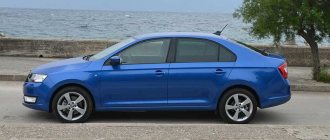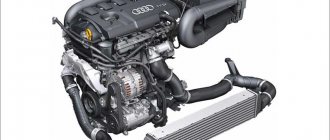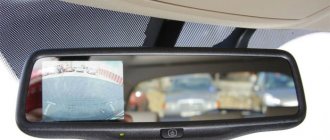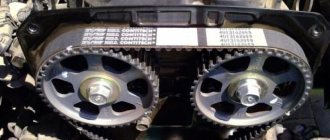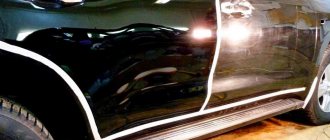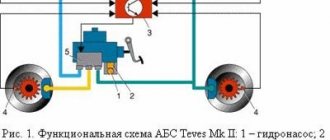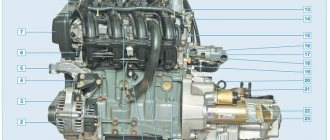What kind of car drive systems exist?
The classical classification implies the existence of three types of drive for a machine. These are front, back and full. But within these types, several more subspecies can be distinguished, which are sometimes worth knowing about when choosing a car. Everything is clear with the front and rear drive options, but the full one raises certain questions, and it is with it that the most difficulties arise when selecting.
So, here are the generally accepted designations for different types of drives:
- FWD (Forward Wheel Drive). This is a traditional front-wheel drive; more than 70% of cars today have exactly this option for transmitting torque to the wheels. The design is classic; in most cases, no subtypes or additional parameters can be distinguished here.
- RWD (Rear Wheel Drive). Under this designation lies traditional rear-wheel drive. The only difference in this torque transmission option is the location of the engine, which determines the design of the transmission. In 99% of cases, the engine is installed in the front, and the torque is transmitted through the driveshaft. But there is also a rear engine location.
- 4WD (Four Wheel Drive). This is a classic all-wheel drive, which can be permanent or plug-in. Previously, these types of technologies could be easily recognized by two levers in the central tunnel. The main difference is the mechanical differential lock, so that it is possible to transmit torque equally to all wheels at once.
- AWD (All Wheel Drive). This is a modern, adapted version of all-wheel drive, where the electronics decide which wheels to connect to the engine at a particular moment in time. Complex electronics and rather poor efficiency were disadvantages of the first AWD cars, but today everything is actively changing.
The last two types of all-wheel drive can also be divided into two more groups. The first will include cars with main rear-wheel drive and a front axle connection. And the second group will initially include front-wheel drive cars with a plug-in rear axle.
Hard plug-in all-wheel drive (Part time) 4WD.
How the start-stop system works in a car, its purpose, pros and cons
https://www.youtube.com/watch?v=xVsxN4K2EcE
The simplest solution for a 4WD vehicle is direct connection of all drive axles. This type of transmission is relatively simple and reliable. Torque is supplied through the gearbox to the transfer case, and from it through articulated drives to the axle differentials. The force from the engine is directly distributed to the front and rear axles in almost equal quantities.
As a result, the amount of torque on both the rear and front wheels becomes almost equal. This torque distribution significantly increases cross-country ability. The car can overcome significant off-road conditions.
To increase torque, another reduction gear, called a range multiplier, is additionally introduced into the 4WD transmission. When downshifting is engaged, the car significantly loses speed, but traction on the wheels increases, which further increases cross-country ability. To drive on loose snow, as well as on viscous soils, it is recommended to engage a downshift.
This design underlies all classic 4WD SUVs - heavy vehicles with a rigid frame base and dependent, often leaf spring suspension with continuous axle beams. The design of the classic 4WD SUV is actually a repetition of the design of cars with the American “general purpose” marking, which literally meant: “general purpose vehicle.” Later, this phrase was transformed into the “jeep” that has become familiar to us.
Increased cross-country ability is facilitated not only by 4WD all-wheel drive with an additional reduction gear. Successful overcoming of off-road conditions is largely facilitated by the successful distribution of the vehicle's weight along the axles, as well as a rigid frame and, of course, a high and powerful suspension, in which the vertical movement of both wheels is rigidly connected to each other.
All this contributes to good off-road performance. If the car uses cross-wheel self-locking differentials, its cross-country ability increases even more. Most “classic” SUVs are cars with powerful engines, a high seating position and impressive overall dimensions. Such cars are capable of overcoming serious off-road conditions, snow drifts, and even crossing shallow bodies of water without strong currents.
Along with well-known advantages, classic 4WD SUVs also have a number of significant disadvantages. The main one is, oddly enough, hard all-wheel drive. The thing is that the torque is distributed equally between the axles of the car. Under some conditions, the angular speeds of the front and rear wheels are not always the same
. And if, when driving on loose soil, this is compensated by wheel slipping, then when driving on a hard and level road surface, dangerous overloads will occur in the transmission. For example, when cornering, due to pressure differences in tires or unequal angular velocities of cardan joints, torsional vibrations occur in the transmission of an SUV, as a result of which the mechanisms easily fail.
To prevent this from happening, one of the drive axles, usually the front one, has the ability to be disconnected from the 4WD transmission. If you have been driving off-road and decide to go onto an asphalt road, you must disengage one of the drive axles before driving on the road. To reduce mechanical losses, many domestic and foreign models of 4WD SUVs are equipped with special couplings with which the front wheels are connected to the transmission.
Some models have vacuum or electromagnetic drive of wheel clutches. Based on this, this type of car is called “part time 4WD”. Increased fuel consumption is another significant drawback of SUVs. The heavy frame structure, cast-iron bridge beams, and large mechanical losses determine the increased fuel appetite of such vehicles.
Advantages of 4WD:
- increased cross-country ability,
- simplicity and reliability of design,
- rigid design.
Disadvantages of 4WD:
- high fuel consumption,
- increased power losses,
- the need to disable one of the drive axes,
- high center of gravity (tendency to tip over).
Read more about what AWD is
Let's take a closer look at the information about AWD - what it is in a car and how to use it. This type of drive system is most often installed on crossovers. They are also used by manufacturers of sedans and station wagons with off-road capabilities. In this case, you will not be able to make the car go with all-wheel drive exactly when you want it. The electronics decide when to connect the rear axle.
Some features of the AWD system:
- in most situations, the front axle will be the main one, the rear axle is connected if necessary;
- there is no forced inclusion, except perhaps software and electronic configuration methods;
- there is no forced differential lock, there can only be electronic imitation;
- the effectiveness of this type of drive is controversial; very often the connection of the rear axle turns out to be untimely;
- the quality of service depends very much on the manufacturer; only an expensive set of sensors solves many issues.
Fans of real jeeps do not accept AWD, considering it insufficiently efficient and weak. But it all depends on the driver’s skills, understanding of his car, as well as the scope of operation of the car. Therefore, it is not worth saying right away that such a drive is bad. You need to study the features of its operation and purpose so as not to expect something unclear from the vehicle.
The drive wheel is hanging in the air
UAZ Patriot.
If the front axle is not connected, the car will stop. When the bridge is connected, all the torque from the engine will go to the “independent” axle, and the car will move on.
Lada 4x4.
If the differential is not locked, the car will stop. If you lock the center differential, it will go further.
Renault Duster.
When the selector is in 2WD position, the car will stop. In the Auto or Lock position, the clutch will engage the rear axle and it will continue to move.
What are the differences between the different types of all-wheel drive technologies?
A logical question when purchasing modern crossovers and SUVs is what is the difference between AWD and 4WD. In fact, the differences are that in the 4WD system you yourself can control the processes of transmitting torque to the wheels, and in the crossover adapted version the electronics do everything for you. Fewer and fewer cars get the classic 4WD option, giving way to more expensive and technologically advanced systems.
As a rule, in cars with 4WD the front axle is disabled, and the rear axle is permanently connected to the transmission system. In AWD the opposite happens. Mechanical locking, adjustments and control capabilities of the drive system are an exclusive privilege of real 4WD jeeps. Classic technology uses a transfer case, which has many functions, but in modern cars, all the work is done by an electronic control system with many automatic functions. As you can see, the difference between 4WD and AWD is quite significant.
Definition
From the very beginning, it is important to define the terminology, since many drivers and vehicle owners confuse AWD and FWD drives. Meanwhile, for four-wheeled vehicles, these terms practically mean the same thing. To summarize, AWD is an automatically connected (or permanent) all-wheel drive. 4WD is also all-wheel drive, which the driver can disable or engage manually.
Note that this terminology is not always followed in the automotive industry, so many buyers are often confused and do not always understand that this is an FWD drive. For example, Subaru Justy or Ford Tempo are marketed as AWD vehicles, although in reality the drive axles are engaged and disengaged manually.
The final confusion in the concepts is brought about by the all-wheel drive system, which can be connected if necessary (on demand four wheel drive). It is difficult to say what is at stake in this case. A similar concept can mean manually connected or automatic all-wheel drive. The press is largely responsible for this confusion, as it is the press that most often makes mistakes when publishing car reviews or press releases.
Are there clear advantages to AWD technologies?
When comparing 4WD or AWD, we can highlight some disadvantages in all technologies. But for now we will try to focus on the benefits. There are many benefits to each all-wheel drive technology if you take advantage of them. For example, a trip around the city in the summer will not demonstrate any advantage of such technology.
But you will get the following advantages in a car with AWD:
- more confident operation of the car on the highway, significantly increased directional stability;
- a confident ride in difficult conditions, which allows you to get out of any trouble without help;
- the ability to move off the asphalt onto moderate off-road conditions when traveling to nature or fishing;
- you don’t need to configure anything, the electronics will perform all the assigned tasks for you without any problems;
- To save fuel, the system will automatically disable all-wheel drive when it is not necessary.
As you can see, this technology has many advantages. Of course, we are talking about AWD in isolation, without comparing the system with other all-wheel drive technology options. However, cars with such options have quite a lot of obvious visible advantages. So under certain conditions, paying extra for all-wheel drive will really be worth the money.
Disadvantages of front-wheel drive
Despite all the advantages and laurels that front-wheel drive has received, the FWD drive type is still considered imperfect and has disadvantages.
A significant disadvantage is ensuring the safety of people in the car. After all, despite the fact that front-wheel drive versions of cars are not as susceptible to skidding as others, they still have the possibility of skidding. And in this case, it will not be very easy to level the car; it requires experience and dexterity; a beginner may not be able to cope.
To cope with front-wheel drive when skidding, experts advise immediately adding gas. Unfortunately, everything usually happens so quickly that drivers sometimes do not have time to react to the situation at the level of instincts. Under no circumstances should you brake to avoid losing control altogether. And if we take into account that with such a drive the wheels are rotary, then there will be a necessary limitation on the angle of rotation.
It is important to know that when picking up speed, part of the total weight of the car is transferred to the rear and the grip on the road surface deteriorates significantly. Because of this, slipping is inevitable if you own a car with FWD drive. Racing in such a car is contraindicated and deadly, no drifting will work on them! With sports cars, everything is different. The advantage of rear-wheel drive RWD is the presence of a rear drive axle, which allows you to drift. Or racing cars still use all-wheel drive.
What are the disadvantages of an AWD drive system?
- Electronics. It all depends on a whole bunch of sensors that can fail at any moment and not turn on the drive or turn it off at the right time.
- No manual settings. For many car buyers, this will be a real problem; you cannot configure anything yourself.
- Incomprehensible moment of turning on the drive. Skidding and other unpleasant situations are quite possible if you do not feel the moment when all-wheel drive is engaged.
- Expensive repairs. AWD systems are incredibly difficult to repair because they are a collection of expensive electronic systems and sensors that are difficult to diagnose.
- High expectations. Often the buyer of a car with AWD believes that he has a real SUV, but more often than not these cars do not live up to such expectations.
- Overpay if you don't need all-wheel drive. Statistics show that more than half of all-wheel drive cars are bought for image rather than for real use.
Let's look at the abbreviations that manufacturers use to mark their all-wheel drive models.
AWD, 4WD, 4x4 - ZR found the most all-wheel drive. The answer will surprise you- We are regularly asked how many sets of snow chains should be purchased for a four-wheel drive vehicle and how many wristbands are required for the vehicle. The answer is simple - it doesn’t matter whether the car has all-wheel drive or not. One set of chains (2 pieces) per axle is sufficient. As for the bracelets, the more of them are installed, the better the car “rows”, and the less wear each bracelet wears out. Recommended quantity: from 6 pcs.
Results and some thoughts about all-wheel drive
In Russia there is a cult of all-wheel drive vehicles, which stems from rather difficult road conditions. But today the roads in the Russian Federation are no longer so terrible; public utilities clean them well. You need all-wheel drive if you live in a village, go hunting or fishing every day, or constantly travel in difficult conditions. Also, in the northern part of the country, jeeps with a truly brutal character are often needed in order not to freeze in a snowdrift. But in other cases, an all-wheel drive car often ends up being wasted money at the showroom.
Consider whether you need all-wheel drive at all. If you decide that it is impossible to live without this option, try to find a car with 4WD. Most often, these are not very beautiful SUVs whose task is to overcome difficulties. There won't be too much comfort in them either. But cars with AWD serve to slightly increase comfort compared to conventional front-wheel drive versions of those same cars. This is far from an SUV that will not please you with its confident cross-country ability.
FWD drive – what is it?
This abbreviation can be read in different ways. At a minimum, there are two options:
- Front Wheel Drive. The car has a front drive axle.
- Full Wheel Drive. The car is all-wheel drive.
There is also an LHD FWD drive. What does it mean? The first three letters mean Left Hand Drive (left-hand drive car), the rest we already know.
Unfortunately, there is no clear definition that accurately describes the type of FWD drive. The car manufacturer himself decides what exactly he means by this concept. Therefore, if in the characteristics of one car these three letters may indicate the presence of front-wheel drive, then in another car this may well be interpreted as all-wheel drive.
Therefore it is not possible to specify exactly which FWD drive is meant. On different machines, this may be a front driven axle or two driven axles.
In general, there are three options: front, rear, full. Each of them has its own pros and cons, implementation features, and characteristics. It's hard to say which one is better. One or another drive is suitable for different conditions and driving styles. Let's try to analyze the features of each of them.
